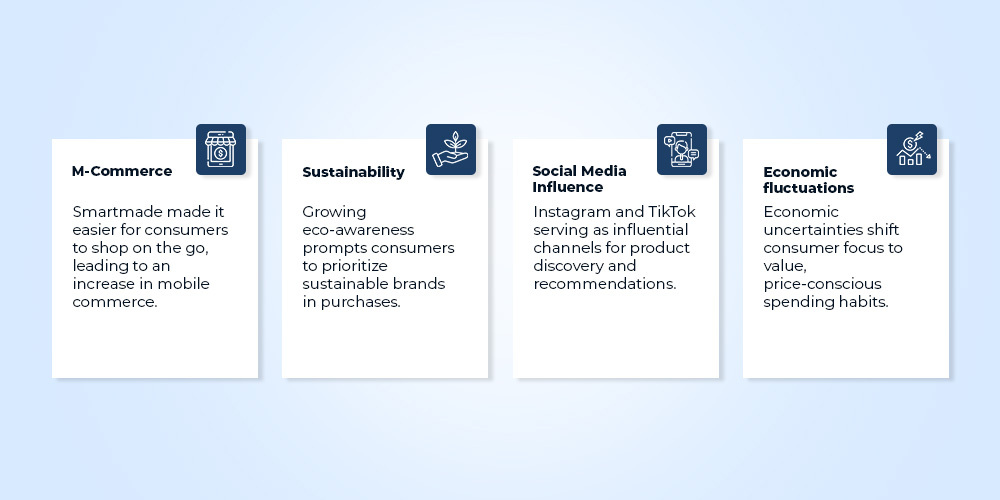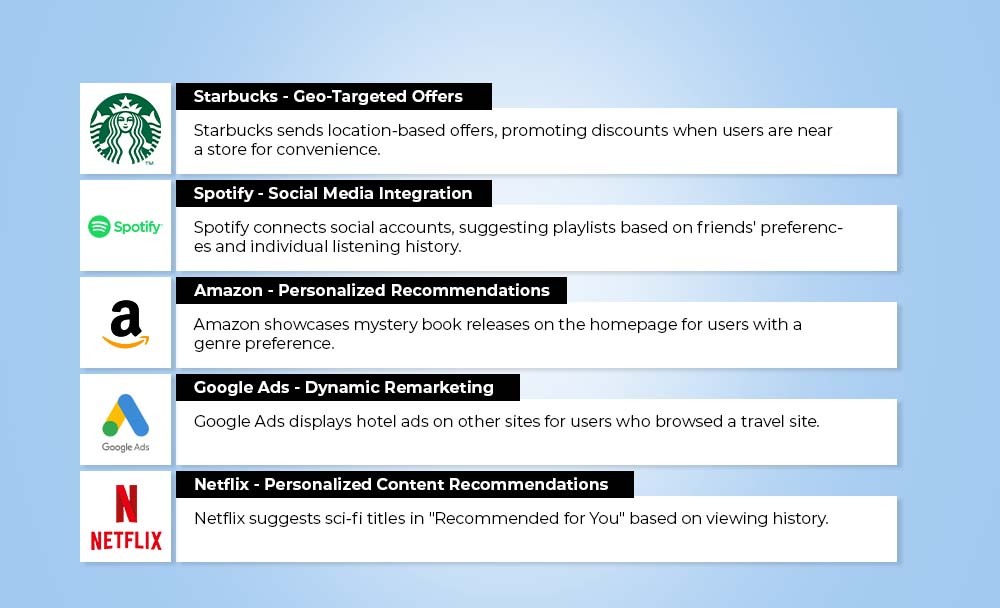

Google Shopping Strategies for Changing Consumer Habits

Running short of time? Get PDF of the blog in your mail.
|
Play Now

|
Navigating the consumer journey nowadays can feel like a puzzle, with shoppers taking unpredictable steps. However, breaking down this complexity is key to connecting with the right audience at the right time and on the right platform. Moreover, let’s explore key consumer behaviors shaping the current journey and master effective Google Shopping strategies for business success.
Aforementioned customer journey will impact the shopping experience in the following ways
- The consumer journey now extends beyond physical stores, with online platforms influencing purchasing decisions.
- The consumer journey becomes omnichannel, as Alex seamlessly transitions between online and offline touchpoints for information and inspiration.
- The consumer journey becomes tailored to Alex’s interests, offering a more personalized and relevant shopping experience.
- The consumer journey combines online research with an in-store touchpoint, showcasing the blend of digital and physical experiences.
- The consumer journey concludes with a seamless online transaction, demonstrating the preference for convenience in the final steps.
Evolving Consumer Behavior And Its Significance In Google Shopping
As consumer preferences, expectations, and purchasing habits change, businesses must adapt their strategies to stay relevant and meet the growing needs of their target audience.
In the context of Google Shopping,
- Consumer behavior is not static. It constantly evolves in response to emerging technologies, cultural shifts, and external events. As a result, Google Shopping, a prominent e-commerce platform, is deeply impacted by these trends.
- Evolving consumer behavior often demands a more personalized shopping experience. Google Shopping, with its data-driven capabilities, allows businesses to gather insights into individual preferences.
- Google Shopping relies heavily on algorithms to display products to potential buyers. After all, adapting to evolving consumer behavior allows businesses to optimize their product listings, ensuring they align with what consumers are actively searching for.
Key Strategies for Adapting To Changing Shopping Trends
As shopping trends shift at an unprecedented pace, businesses must embrace adaptive strategies to navigate the dynamic landscape successfully.
Consumer Journey Evolution: More Thoughtful Decision-Making
- Increased Thoughtfulness
- Behavior Change: Consumers exhibit a more thoughtful approach in their decision-making process, being conscious of what, where, and how they make purchases.
- Google Search Dependency: Throughout the entire journey, from inspiration to purchase, consumers heavily rely on Google Search to find answers to their queries.
- Research Trend
- Survey Insight: Globally, 32% of consumers in surveyed markets are conducting more research on purchases while actively shopping.
- Implication: Emphasizes the importance of meeting consumers at various stages of their journey and underscores the need for a robust digital presence.
- Strategic Recommendations
- Digital Presence Importance: It is crucial for businesses, especially Google Shopping sellers, to establish a strong and informative digital presence.
- Value Proposition Considerations
- Strategic Thinking: Businesses should dedicate time to pondering the value they offer consumers.
- Information Equipping: The strategy should intentionally equip customers with valuable information to support their purchasing decisions.
- Quality Over Discounts
- While pricing is crucial, consumers also prioritize quality over discounts. Product benefits, especially quality, should be communicated clearly.
- Beyond discounts, sellers should communicate product benefits clearly, emphasizing quality. This ensures a more comprehensive approach to influencing purchase decisions.
- Impact on Google Shopping Sellers
- Strategic Communication: Google Shopping sellers must align their strategies to meet consumers where they are in the decision-making process.
Consumer Online Shopping Behavior Has Been Influenced By Various Factors
Google Shopping Strategy For Optimizing Product Listings
Optimizing Google Shopping product listings is crucial for businesses looking to align with evolving trends in customer online shopping behavior. Here are some tried and tested Google Shopping strategy to enhance your Google Shopping product listings.
High-Quality Product Images
- Use high-resolution images that showcase your products from multiple angles.
- Follow Google’s image requirements to ensure your images meet the necessary standards.
- Example : If you’re selling clothing, include images of models wearing the items to help customers visualize how the product looks when worn.
Accurate and Detailed Product Titles
- Craft clear, concise, and descriptive product titles that include relevant keywords.
- Prioritize important product attributes in the title, such as brand, color, size, and key features.
- Example: Instead of just “Running Shoes,” use “Nike Air Zoom Pegasus 37 Men’s Running Shoes” to provide more details and improve product visibility.
Informative Product Descriptions
- Write compelling and detailed product descriptions that highlight key features and benefits.
- Include relevant information about materials, dimensions, and any unique selling points.
- Example:For electronic gadgets, include technical specifications, warranty information, and details about unique features in the product description.
Utilize Rich Product Data
- Leverage all available attributes in your product feed, including custom labels, product type, and item group ID.
- Provide as much information as possible to enhance the visibility and relevance of your products.
- Example: If you’re selling furniture, use attributes like material, color, dimensions, and style to help customers find exactly what they’re looking for.
Pricing and Promotion Optimization
- Ensure that your product prices are competitive. Google Shopping users often compare prices before making a purchase.
- Highlight any promotions, discounts, or special offers in your product listings.
- Example:Offering a limited-time discount on “Back-to-School Backpacks” can encourage quick purchases, especially during the back-to-school season.
Customer Reviews and Ratings
- Encourage customers to leave reviews and ratings for your products.
- Showcase positive reviews in your product listings to build trust and credibility.
- Example: If your product has received high ratings and positive reviews, display a snippet like “Rated 4.8/5 by 200+ customers” to highlight its popularity.
Mobile-Friendly Listings
- Optimize your product listings for mobile devices, as a significant portion of online shoppers use smartphones and tablets.
- Ensure that images and text are easily viewable and navigable on smaller screens.
- Example: Optimize images and text for smaller screens, and consider implementing mobile-specific features like swipeable image galleries.
Local Inventory Ads (if applicable)
- If you have physical stores, using Local Inventory Ads to showcase products available in nearby stores will be an effective Google Shopping strategy.
- Provide accurate and up-to-date information on local inventory.
- Example: A user searching for “running shoes near me” might see an ad with a map, showing the availability of specific shoe models in a local store.
By implementing these tips, businesses can enhance their Google Shopping product listings to align with evolving trends and provide customers with a better online shopping experience
Google Shopping Strategy For Personalized Shopping Experience
As consumer preferences and online shopping habits change, merchants must adapt Google Shopping to address these shifts to effectively engage customers. Moreover, Personalized experiences stand out in a crowded market, capturing the attention of consumers who are overwhelmed with choices.
Implement remarketing campaigns that focus on specific product categories. For instance, if a user has browsed women’s athletic shoes, create a remarketing ad that highlights popular or new arrivals in the women’s athletic shoe category.
- Cross-sell products that complement what users have already shown interest in or purchased. As a result, when a user buys a smartphone, display ads for compatible accessories like phone cases, screen protectors, and headphones.
- Create personalized product bundles based on user preferences and past interactions. Suppose a user has shown interest in home fitness equipment, display an ad for a personalized bundle that includes dumbbells, resistance bands, and a yoga mat at a discounted price.
Mobile- Friedly Listings
- Optimize your product listings for mobile devices, as a significant portion of online shoppers use smartphones and tablets.
- Ensure that images and text are easily viewable and navigable on smaller screens.
- Example: Optimize images and text for smaller screens, and consider implementing mobile-specific features like swipeable image galleries.
Strategies Adopted By Leading Brands For Navigating Shifts in Customer Shopping Behavior
Let’s look at real-world examples of businesses implementing personalized shopping experiences on Google
As a Google Shopping merchant you can implement this strategy to optimize product listings and utilize Google’s dynamic remarketing features.
Wrapping It Up – Google Shopping Strategy for Evolving Consumer Behaviors
In essence, the modern consumer journey has become intricate, requiring businesses, especially Google Shopping sellers, to navigate unpredictability with strategic precision. Therefore, Google Shopping sellers should optimize product listings with high-quality images, accurate titles, informative descriptions, rich product data, and competitive pricing to cater to changing preferences.
As a result, the adaptability of aforementioned Google Shopping strategies will play vital role in navigating the evolving landscape of consumer behavior.


